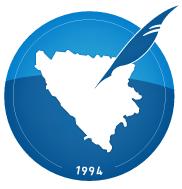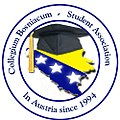Collegium Bosniacum
| Collegium Bosniacum Bosnian-Herzegovinian student aid association |
|
|---|---|
 The Collegium Bosniacum's coat of arms since 2011 |
|
| Seat of the organs | Vienna |
| Chair | Haris Kafedzic (President) |
| Official and working languages | |
| founding |
October 14, 1994 |
| www.collegium-bosniacum.org | |
The Collegium Bosniacum is a non-partisan and non- denominational advocacy group for Bosnian-Herzegovinian students in Vienna. The association was founded in October 1994 by students from Bosnia-Herzegovina in Vienna in order to create an association of natural and legal persons for the purpose of representing members in problematic cases. The association is the oldest still existing association of Bosnian-Herzegovinian immigrants in Vienna.
history
The founding years 1994 to 1998
The association began in the early 1990s in Vienna. While new ideologies and ways of thinking were part of the agenda in socialist Yugoslavia , the first parties in Vienna were organized by the then few students. When war broke out in the sovereign and independent Republic of Bosnia-Herzegovina in the spring of 1992, a slightly larger number of students came to Austria as refugees . The number grew to almost 500 by 1995 with Bosnian-Herzegovinian citizenship. So two students and one student decided to network and represent this community through an association. The group grew rapidly around Mirsad Jačević, Ivana Križanić and Faris Kapić.
In the first years of activity, arranging scholarships from the World University Service and various networking activities were among the main tasks of the association in addition to cultural events. After the Peace of Dayton in Bosnia-Herzegovina in 1995, various bilateral agreements were created with European countries. This made it possible for more and more people from Bosnia-Herzegovina to study in EU countries. In addition, the children of migrants and refugees grew up slowly. In 1995 there were still almost 500 students from Bosnia-Herzegovina at the universities in Austria, the number rose to almost 900 in five years. In 2005 the number was just under 1900 and five years later the number rose to a little more than 2,600. The majority of the students at around 1700 come from the city of Vienna, followed by Graz with just under 800. The fields of responsibility of the Collegium Bosniacum also changed .
After the turn of the millennium
After the turn of the millennium, new internal structures were created to make the work of the board easier. Lectures have been set up so that the work is well coordinated and shared. The new task was to absorb the large influx of new students from Bosnia-Herzegovina and to integrate them into the Austrian university operations as best as possible. To this end, several projects for the return of graduates to Bosnia-Herzegovina were also implemented. In the summer of 2007, on the initiative of students from the United States, the Mlada dijaspora Bosne i Hercegovine was established with the Collegium Bosniacum as one of the founding members. This organization was the umbrella organization for all Bosnian-Herzegovinian youth and student organizations outside of Bosnia-Herzegovina.
Another change to the internal structure was made by the new Executive Board between April and October 2011. A general overhaul was achieved within six months, from the addition of the name to the new club coat of arms, and a project was implemented with the United World College from Mostar . A large part of the advice is provided by various websites of the Austrian Students' Union and various non-governmental organizations in English and / or in German. Due to new laws, all but minor exceptions who come to Austria to study have to prove that they have already completed a German course in their country of origin. Therefore, the organizations offered orientation aids to those whose target university is in Vienna. There are also various events that aim to network students in Vienna with one another. However, the traditional values of the association, with which its own channels continue to provide advice on all aspects of studies, have been retained.
Projects (one-time and according to importance since 1994)
- 10th anniversary of the Sarajevo Winter Olympics (1994)
- Mediation of scholarships for students in Vienna (1994–1996)
- Opening of the Collegium Bosniacum Forum for studying in Austria (2002)
- Collegium Bosniacum Homepage (2003)
- Job exchange return (2004)
- Exchange of experiences (2004)
- Homepage studenti.at about studying in Austria (2005)
- Exchange of experiences part 2 (2006)
- Career Days (2007)
- Development of a student database (2008)
- Guide to the Universities of Vienna (2010)
- Workshop for students of the United World College Mostar in Vienna (2011)
- BOSONA - Bosnia-Herzegovina with a difference! (2012)
- CBNetwork - Information portal for students on BKS (2012)
- Austria's Investments in Bosnia-Herzegovina: Current Issues and Future Opportunities (2012)
Bosnian-Herzegovinian Students Support Award
The BOSNIAN-HERZEGOVINIAN STUDENTS SUPPORT AWARD (BHSSA) has been awarded annually since 2011 and is donated by Collegium Bosniacum . The prize is awarded to those who have directly or indirectly provided the Bosnian-Herzegovinian students in Austria with the greatest benefit. The origin or the country of activity is not taken into account. In order to be eligible for the award, one must be nominated, although not everyone has the right to nominate. Only living persons can be nominated. It is not possible to nominate yourself. The nomination deadline is October 1st of each year. The award ceremony itself takes place on November 25th each year. The prize can generally also be awarded to institutions and associations.
Previous winners
- DI Enida Suljagić (2011)
Club badge
The first “coat of arms” was modeled after the shield of the Spanish form, which was established in Spain in the 13th century. The shield resembled a U. It contained the symbols of an arm reaching for the book as a symbol of knowledge, as well as the Bosnian lily ( the heraldic flower of the House of Anjou ). The arm was integrated as a recognizable symbol of the history of Bosnia-Herzegovina, with the difference that this arm holds a book instead of a sword. The arm is modeled on the shield coat of arms of the medieval Bosnian military commander Hrvoje Vukčić Hrvatinić (born 1350 in Kotor, in today's Kotor Varoš, BiH). This coat of arms adorned the red and yellow flag of Bosnia-Herzegovina under the sovereignty of Austria-Hungary from 1878 to 1908. In the book itself, the initial C for Collegium and on the second page a B for Bosniacum was used. In the top right corner, the Bosnian lily was to be found in the coat of arms as a symbol of the historical state of Bosnia and the Kotromanić royal family . It is a legacy from the Anjou dynasty after the marriage of the Hungarian King Ludwig I with the daughter of the Bosnian Ban Stjepan II. Kotromanić (1292–1353), Elizabeta Kotromanić (1340–1387) in 1353. This coat of arms was based on chosen those symbols that Bosnia-Herzegovina and its population recognized through the past almost a thousand years. This club crest remained until summer 2008.
The board of directors, newly elected in spring 2008, had a new coat of arms modeled on the new flag of Bosnia-Herzegovina , a triangle with seven full and two half white stars on a blue background. The flag was integrated in the borders of the state of Bosnia-Herzegovina with an attached doctoral cap , surrounded by two blue rings. Between the rings stood Collegium Bosniacum - Student Association and In Austria since 1994 . This new coat of arms should indicate a new, integrative, European way.
The newly elected board in April 2011 then changed the club's coat of arms a third time in the overall package of changes in the club. The symbolism of a circle like Bosnia-Herzegovina was preserved. The circle is filled with the color blue and in the middle a white Bosnia-Herzegovina. This includes a blue feather that points to the center of the country. The circle stands for a community and symbolizes wisdom and clarity with the blue color. The color white in the form of Bosnia-Herzegovina stands for the science and accuracy that students have to learn during their studies as well as in everyday life in order to be successful. The concentration of symbols has been minimized. For this, a simple and yet recognizable symbol was created through the simple use of geometry and symbolism as well as two manageable colors.
history
Individual evidence
- ↑ Project description on the homepage of the Collegium Bosniacum ( page no longer available , search in web archives ) Info: The link was automatically marked as defective. Please check the link according to the instructions and then remove this notice.
- ↑ Project description on the homepage of the Collegium Bosniacum ( page no longer available , search in web archives ) Info: The link was automatically marked as defective. Please check the link according to the instructions and then remove this notice.
- ↑ Project description on the homepage of the Collegium Bosniacum ( page no longer available , search in web archives ) Info: The link was automatically marked as defective. Please check the link according to the instructions and then remove this notice.
- ↑ Project description on the homepage of the Collegium Bosniacum ( page no longer available , search in web archives ) Info: The link was automatically marked as defective. Please check the link according to the instructions and then remove this notice.
- ↑ Project description on the homepage of the Collegium Bosniacum ( page no longer available , search in web archives ) Info: The link was automatically marked as defective. Please check the link according to the instructions and then remove this notice.
- ↑ Project description on the homepage of the Collegium Bosniacum ( page no longer available , search in web archives ) Info: The link was automatically marked as defective. Please check the link according to the instructions and then remove this notice.
- ↑ Project description on the homepage of the Collegium Bosniacum ( page no longer available , search in web archives ) Info: The link was automatically marked as defective. Please check the link according to the instructions and then remove this notice.
- ^ Report in the Austrian migrant magazine KOSMO
- ↑ Project description on the homepage of the Collegium Bosniacum ( page no longer available , search in web archives ) Info: The link was automatically marked as defective. Please check the link according to the instructions and then remove this notice.
- ↑ Project description on the website of the Collegium Bosniacum ( Memento of the original from July 1, 2012 in the Internet Archive ) Info: The archive link was inserted automatically and has not yet been checked. Please check the original and archive link according to the instructions and then remove this notice.
- ↑ Project description on the website of the Collegium Bosniacum ( Memento of the original from June 30, 2012 in the Internet Archive ) Info: The archive link has been inserted automatically and has not yet been checked. Please check the original and archive link according to the instructions and then remove this notice.
- ↑ Press release Austrian migrant media press agency


